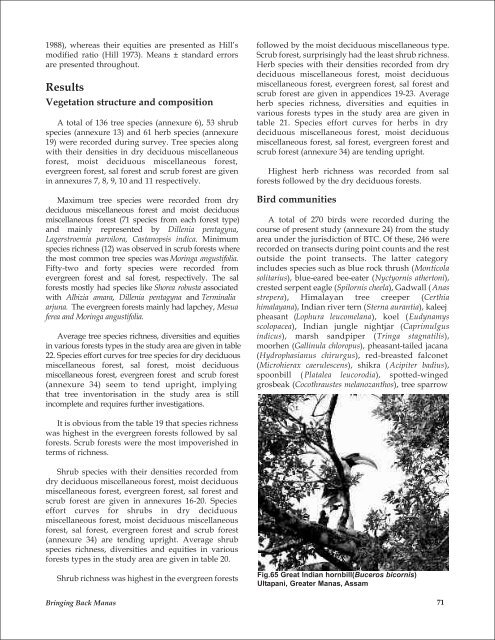Bringing Back Manas
Bringing Back Manas
Bringing Back Manas
- TAGS
- bringing
- manas
- www.ifaw.org
You also want an ePaper? Increase the reach of your titles
YUMPU automatically turns print PDFs into web optimized ePapers that Google loves.
1988), whereas their equities are presented as Hill’s<br />
modified ratio (Hill 1973). Means ± standard errors<br />
are presented throughout.<br />
Results<br />
Vegetation structure and composition<br />
A total of 136 tree species (annexure 6), 53 shrub<br />
species (annexure 13) and 61 herb species (annexure<br />
19) were recorded during survey. Tree species along<br />
with their densities in dry deciduous miscellaneous<br />
forest, moist deciduous miscellaneous forest,<br />
evergreen forest, sal forest and scrub forest are given<br />
in annexures 7, 8, 9, 10 and 11 respectively.<br />
Maximum tree species were recorded from dry<br />
deciduous miscellaneous forest and moist deciduous<br />
miscellaneous forest (71 species from each forest type)<br />
and mainly represented by Dillenia pentagyna,<br />
Lagerstroemia parvilora, Castanopsis indica. Minimum<br />
species richness (12) was observed in scrub forests where<br />
the most common tree species was Moringa angustifolia.<br />
Fifty-two and forty species were recorded from<br />
evergreen forest and sal forest, respectively. The sal<br />
forests mostly had species like Shorea robusta associated<br />
with Albizia amara, Dillenia pentagyna and Terminalia<br />
arjuna. The evergreen forests mainly had lapchey, Mesua<br />
ferea and Moringa angustifolia.<br />
Average tree species richness, diversities and equities<br />
in various forests types in the study area are given in table<br />
22. Species effort curves for tree species for dry deciduous<br />
miscellaneous forest, sal forest, moist deciduous<br />
miscellaneous forest, evergreen forest and scrub forest<br />
(annexure 34) seem to tend upright, implying<br />
that tree inventorisation in the study area is still<br />
incomplete and requires further investigations.<br />
It is obvious from the table 19 that species richness<br />
was highest in the evergreen forests followed by sal<br />
forests. Scrub forests were the most impoverished in<br />
terms of richness.<br />
Shrub species with their densities recorded from<br />
dry deciduous miscellaneous forest, moist deciduous<br />
miscellaneous forest, evergreen forest, sal forest and<br />
scrub forest are given in annexures 16-20. Species<br />
effort curves for shrubs in dry deciduous<br />
miscellaneous forest, moist deciduous miscellaneous<br />
forest, sal forest, evergreen forest and scrub forest<br />
(annexure 34) are tending upright. Average shrub<br />
species richness, diversities and equities in various<br />
forests types in the study area are given in table 20.<br />
Shrub richness was highest in the evergreen forests<br />
<strong>Bringing</strong> <strong>Back</strong> <strong>Manas</strong><br />
followed by the moist deciduous miscellaneous type.<br />
Scrub forest, surprisingly had the least shrub richness.<br />
Herb species with their densities recorded from dry<br />
deciduous miscellaneous forest, moist deciduous<br />
miscellaneous forest, evergreen forest, sal forest and<br />
scrub forest are given in appendices 19-23. Average<br />
herb species richness, diversities and equities in<br />
various forests types in the study area are given in<br />
table 21. Species effort curves for herbs in dry<br />
deciduous miscellaneous forest, moist deciduous<br />
miscellaneous forest, sal forest, evergreen forest and<br />
scrub forest (annexure 34) are tending upright.<br />
Highest herb richness was recorded from sal<br />
forests followed by the dry deciduous forests.<br />
Bird communities<br />
A total of 270 birds were recorded during the<br />
course of present study (annexure 24) from the study<br />
area under the jurisdiction of BTC. Of these, 246 were<br />
recorded on transects during point counts and the rest<br />
outside the point transects. The latter category<br />
includes species such as blue rock thrush (Monticola<br />
solitarius), blue-eared bee-eater (Nyctyornis athertoni),<br />
crested serpent eagle (Spilornis cheela), Gadwall ( Anas<br />
strepera), Himalayan tree creeper (Certhia<br />
himalayana), Indian river tern (Sterna aurantia), kaleej<br />
pheasant (Lophura leucomelana), koel (Eudynamys<br />
scolopacea), Indian jungle nightjar (Caprimulgus<br />
indicus), marsh sandpiper (Tringa stagnatilis),<br />
moorhen (Gallinula chloropus), pheasant-tailed jacana<br />
(Hydrophasianus chirurgus), red-breasted falconet<br />
(Microhierax caerulescens), shikra ( Acipiter badius),<br />
spoonbill ( Platalea leucorodia), spotted-winged<br />
grosbeak (Cocothraustes melanozanthos), tree sparrow<br />
Fig.65 Great Indian hornbill(Buceros bicornis)<br />
Ultapani, Greater <strong>Manas</strong>, Assam<br />
71

















